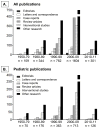Severe asthma in childhood: recent advances in phenotyping and pathogenesis
- PMID: 22249197
- PMCID: PMC3310912
- DOI: 10.1097/ACI.0b013e32835090ac
Severe asthma in childhood: recent advances in phenotyping and pathogenesis
Abstract
Purpose of review: Children with severe asthma have a high degree of respiratory morbidity despite treatment with high doses of inhaled corticosteroids and are therefore very difficult to treat. This review will discuss phenotypic and pathogenic aspects of severe asthma in childhood, as well as remaining knowledge gaps.
Recent findings: As a group, children with severe asthma have a number of distinct phenotypic features compared with children with mild-to-moderate asthma. Clinically, children with severe asthma are differentiated by greater allergic sensitization, increased exhaled nitric oxide, and significant airflow limitation and air trapping that worsens as a function of age. These findings are accompanied by structural airway changes and increased and dysregulated airway inflammation and oxidant stress which may explain the differential nature of corticosteroid responsiveness in this population. Because children with severe asthma themselves are a heterogeneous group, current efforts are focused on improved definition and sub-phenotyping of the disorder. Whereas the clinical relevance of phenotyping approaches in severe asthma is not yet clear, they may provide important insight into the mechanisms underlying the disorder.
Summary: Improved classification of severe asthma through unified definitions, careful phenotypic analyses, and mechanism-focused endotyping approaches may ultimately advance knowledge and personalized treatment.
Conflict of interest statement
Leonard Bacharier is on the Speaker’s bureau and/or has received honoraria from Merch and GlaxoSmithKline. Leonard Bacharier and Anne Fitzpatrick receive research funding from the National Institutes of Health. Carlos E. Baena-Cagnani has no disclosures relevant to this work.
Figures



Similar articles
-
Clinical aspects of using exhaled NO in asthma diagnosis and management.Clin Respir J. 2012 Oct;6(4):193-207. doi: 10.1111/crj.12001. Clin Respir J. 2012. PMID: 22898078 Review.
-
Phenotypes of severe asthma among children and adolescents in Brazil: a prospective study.BMC Pulm Med. 2015 Apr 17;15:36. doi: 10.1186/s12890-015-0029-8. BMC Pulm Med. 2015. PMID: 25912047 Free PMC article.
-
Exhaled breath temperature measurement and asthma control in children prescribed inhaled corticosteroids: A cross sectional study.Pediatr Pulmonol. 2016 Jan;51(1):13-21. doi: 10.1002/ppul.23204. Epub 2015 Apr 27. Pediatr Pulmonol. 2016. PMID: 25917297
-
Use of exhaled nitric oxide measurement to identify a reactive, at-risk phenotype among patients with asthma.Am J Respir Crit Care Med. 2010 May 15;181(10):1033-41. doi: 10.1164/rccm.200905-0695OC. Epub 2010 Feb 4. Am J Respir Crit Care Med. 2010. PMID: 20133930 Free PMC article.
-
Exhaled nitric oxide: a test for diagnosis and control of asthma?Curr Allergy Asthma Rep. 2007 Nov;7(6):459-63. doi: 10.1007/s11882-007-0070-7. Curr Allergy Asthma Rep. 2007. PMID: 17986377 Review.
Cited by
-
Oxidative Stress Promotes Corticosteroid Insensitivity in Asthma and COPD.Antioxidants (Basel). 2021 Aug 24;10(9):1335. doi: 10.3390/antiox10091335. Antioxidants (Basel). 2021. PMID: 34572965 Free PMC article. Review.
-
High-Flow Nasal Cannula: A Promising Oxygen Therapy for Patients with Severe Bronchial Asthma Complicated with Respiratory Failure.Can Respir J. 2020 Feb 20;2020:2301712. doi: 10.1155/2020/2301712. eCollection 2020. Can Respir J. 2020. PMID: 32211084 Free PMC article. Clinical Trial.
-
Current concepts of severe asthma.J Clin Invest. 2016 Jul 1;126(7):2394-403. doi: 10.1172/JCI84144. Epub 2016 Jul 1. J Clin Invest. 2016. PMID: 27367183 Free PMC article. Review.
-
Effectiveness of single dose oral dexamethasone versus multidose prednisolone for treatment of acute exacerbations of asthma among children.Ann Med Surg (Lond). 2022 Nov 8;84:104799. doi: 10.1016/j.amsu.2022.104799. eCollection 2022 Dec. Ann Med Surg (Lond). 2022. PMID: 36536728 Free PMC article.
-
Atopic phenotypes identified with latent class analyses at age 2 years.J Allergy Clin Immunol. 2014 Sep;134(3):722-727.e2. doi: 10.1016/j.jaci.2014.01.022. Epub 2014 Mar 15. J Allergy Clin Immunol. 2014. PMID: 24636082 Free PMC article.
References
-
- Haselkorn T, Fish JE, Zeiger RS, et al. Consistently very poorly controlled asthma, as defined by the impairment domain of the Expert Panel Report 3 guidelines, increases risk for future severe asthma exacerbations in The Epidemiology and Natural History of Asthma: Outcomes and Treatment Regimens (TENOR) study. J Allergy Clin Immunol. 2009;124(5):895–902. e1–4. - PubMed
-
- Sullivan SD, Wenzel SE, Bresnahan BW, et al. Association of control and risk of severe asthma-related events in severe or difficult-to-treat asthma patients. Allergy. 2007;62(6):655–60. - PubMed
Publication types
MeSH terms
Substances
Grants and funding
LinkOut - more resources
Full Text Sources
Medical
Research Materials

